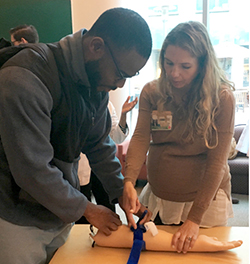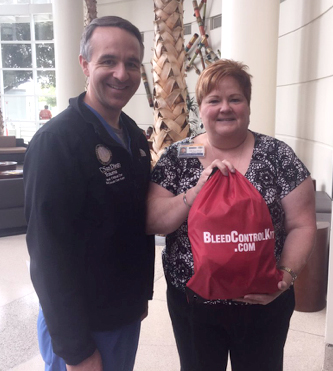Training Bystanders to Stop the Bleeding
January 19, 2018 | Lindsay Morgan
Mass casualty events—particularly mass shootings—are an increasingly common part of American life. According to the Gun Violence Archive, there is a mass shooting 1 in the United States once every two months, a higher frequency than the average gap of 162 days from 2000 to 2010, according to data compiled by Mother Jones .
 While debates about how to prevent mass casualty events continue, efforts are underway to save lives when they happen. The Stop the Bleed campaign, launched in October of 2015 by the American College of Surgeons (ACS) Committee on Trauma and supported by the White House under the Obama Administration, “is a national awareness campaign intended to cultivate grassroots efforts that encourage bystanders to become trained, equipped, and empowered to help in a bleeding emergency before professional help arrives.”
While debates about how to prevent mass casualty events continue, efforts are underway to save lives when they happen. The Stop the Bleed campaign, launched in October of 2015 by the American College of Surgeons (ACS) Committee on Trauma and supported by the White House under the Obama Administration, “is a national awareness campaign intended to cultivate grassroots efforts that encourage bystanders to become trained, equipped, and empowered to help in a bleeding emergency before professional help arrives.”
After a traumatic injury, hemorrhage is responsible for over 35% of pre-hospital deaths and over 40% of deaths within the first 24 hours. In mass casualty events in particular, people frequently die from uncontrolled extremity hemorrhage—bleeding from large vessels in the arms and legs, which can be prevented with proper training and supplies. Uncontrolled bleeding can lead to death within five to 10 minutes—and bystanders are often best positioned to help. But most people lack the knowledge of what to do.
The Stop the Bleed campaign aims to fill this gap by teaching basic bleeding control techniques to civilians and advocating for the placement of bleeding control kits (tourniquets, gauze) in public places so that bleeding control supplies are easily accessible.
 UC San Diego’s Division of Trauma, Surgical Critical Care, Burns, and Acute Care Surgery is leading this effort in San Diego and Imperial County, along with the region’s other trauma centers, and TREF —the Trauma Research & Education Foundation, the education and outreach arm of the San Diego County Regional Trauma System. UC San Diego’s trauma team has led training courses at the San Diego International Airport, San Diego Convention Center, Petco Park, for the UC San Diego Police, and the city of Chula Vista among others. They have also partnered with UC San Diego Emergency Management to provide training courses for UC San Diego Health employees and to place bleeding control stations across the UC San Diego Health Campus.
UC San Diego’s Division of Trauma, Surgical Critical Care, Burns, and Acute Care Surgery is leading this effort in San Diego and Imperial County, along with the region’s other trauma centers, and TREF —the Trauma Research & Education Foundation, the education and outreach arm of the San Diego County Regional Trauma System. UC San Diego’s trauma team has led training courses at the San Diego International Airport, San Diego Convention Center, Petco Park, for the UC San Diego Police, and the city of Chula Vista among others. They have also partnered with UC San Diego Emergency Management to provide training courses for UC San Diego Health employees and to place bleeding control stations across the UC San Diego Health Campus.
“We all have to be ready,” says Dr. Todd Costantini, director of the UC San Diego Trauma Center in Hillcrest and Assistant Professor of Surgery at UC San Diego. “When it comes to disaster response, the lesson we’ve learned is that it’s preparedness that makes a difference.”
Costantini, along with Dr. Jay Doucet, Interim Chief of the Division of Trauma, Surgical Critical Care, Burns, and Acute Care Surgery and Director of Surgical Intensive Care, and Dr. Laura Godat, assistant clinical professor of surgery, are the local representatives of the ACS Committee on Trauma , which promotes and disseminates the Stop the Bleed program nationally.
 Nearly 1,000 individuals have been trained in San Diego so far, and courses are planned for across San Diego and Imperial counties in the coming year.
Nearly 1,000 individuals have been trained in San Diego so far, and courses are planned for across San Diego and Imperial counties in the coming year.
In addition to training, advocacy is a key component of the Stop the Bleed campaign. Says Costantini: “The goal is to have bleeding control kits on the wall in public places, in the same way that you see AEDs [automated external defibrillators] mounted on the wall in airports and shopping malls.”
Costantini and Doucet travelled to the State Capitol in Sacramento last spring to teach a Bleeding Control Course and to testified in front of the California State Assembly in support of Stop the Bleed, and “there was wide support for the initiative. The issue is funding.”
Indeed, AB909 was introduced in California in the spring of 2017. If passed, it would require bleeding trauma kits to be installed next to all automatic defibrillators in the state—and would protect individuals from liability if they use them. However, the bill is currently languishing in appropriations; no funding is earmarked for the initiative.
And bleeding control kits and supplies are expensive. Individual bleeding control kits range from $50-80 each, while wall-mounted public bleeding control stations cost up to $800 each.
UC San Diego Trauma has several training courses lined up for 2018 , and will continue to advocate for government support for supplies. “Stop the Bleed is a way to build resiliency nationally against mass casualty events,” says Costantini, “and with this basic bleeding control training and supplies, ordinary bystanders can potentially save lives.”
1. Mass shooting is defined as any incident in which a gunman shoots or kills four or more people in the same general time and location. Broader definitions of mass shootings include not only shootings in which four or more people are killed, but also those in which four or more people are shot at period.
